Miami Chill |
|||||||||||||||||||||||||||||||||||||||||||
 |
 |
||||||||||||||||||||||||||||||||||||||||||
Crocheted top in DROPS Muskat. Piece is crocheted with texture pattern. Size: S - XXXL
DROPS 199-52 |
|||||||||||||||||||||||||||||||||||||||||||
|
---------------------------------------------------------- EXPLANATION FOR THE PATTERN: ---------------------------------------------------------- PATTERN: See diagrams A.1 to A.3. (A.2 shows how round begins/ends when working in the round.) CROCHET INFO (applies when working back and forth): At beginning of every round with treble crochet work 3 chain stitches (these chain stitches do not replace first treble crochet). At beginning of every round with double crochet work 1 chain stitch (this chain stitch does not replace first double crochet). DECREASE TIP-1: TREBLE CROCHET: Decrease 1 treble crochet by working 2 treble crochets together as follows: Work 1 treble crochet in first stitch, but wait with last yarn over and pull through (= 2 loops on hook), work 1 treble crochet in next stitch/around chain stitch, but on last pull through pull yarn through all 3 loops on hook (= 1 treble crochet decreased). DOUBLE CROCHET: Decrease 1 double crochet by working 2 double crochets together as follows: Work 1 double crochet but wait with last yarn over and pull through (= 2 loops on hook), then work next double crochet but on last pull through, pull yarn through all 3 loops on hook (= 1 double crochet decreased) DECREASE TIP-2 (evenly): To calculate how to decrease evenly, use the total number of stitches (e.g. 144 stitches) and divide stitches by number of decreases to be done (e.g. 6) = 24. In this example work approx. every 23rd and 24th stitch together. ---------------------------------------------------------- START THE PIECE HERE: ---------------------------------------------------------- TOP - SHORT OVERVIEW OF THE PIECE: There is a 8 cm vent at the bottom of top, first work piece back and forth until vent is done, then work piece in the round but turn on every round and work back on round to make the texture the same all the way. When piece is divided at the armhole, work back and forth again. BACK PIECE: Work 83-90-97-104-118-132 chain stitches on hook size 4 mm with Muskat. Continue with 1 double crochet in 2nd chain stitch from hook, then 1 double crochet in each of the next 4 chain stitches, * skip 1 chain stitch, 1 double crochet in each of the next 6 chain stitches *, repeat from *-* the entire row = 72-78-84-90-102-114 double crochets (chain stitch to turn with is also counted as 1 double crochet). Turn and work 1 double crochet in every double crochet. Now work according to diagram A.1 - read CROCHET INFO and REMEMBER CROCHET TENSION! After 8 cm put piece aside and work the front piece. FRONT PIECE: Work 83-90-97-104-118-132 chain stitches on hook size 4 mm with Muskat. Continue with 1 double crochet in 2nd chain stitch from hook, then 1 double crochet in each of the next 4 chain stitches, * skip 1 chain stitch, 1 double crochet in each of the next 6 chain stitches *, repeat from *-* the entire row = 72-78-84-90-102-114 double crochets (chain stitch to turn with is also counted as 1 double crochet). Turn and work 1 double crochet in every double crochet. Now work according to diagram A.1. Continue until piece measures 8 cm - finish on the same row as on back piece. TOP after vent: Continue pattern like this - first work stitches over back piece, then work stitch over front piece, then work round together with a slip stitch in 1st/3rd stitch at beginning of round, work chain stitch/chain stitches in A.2, turn piece and work back, finish with 1 slip stitch in 1st/3rd/4th chain stitch at beginning of round. Insert 1 marker thread in transitions between front and back piece = sides. Continue like this back and forth with pattern according to diagram A.1 and A.2. On rounds with treble crochets or double crochets there are now 144-156-168-180-204-228 stitches on round (A.2 is not counted in number of stitches). When piece measures approx. 10-11-12-13-14-15 cm - adjust so that next round is a round with treble crochets or double crochets (marked on diagram with arrow), decrease 6 stitches evenly - read DECREASE TIP-1 and DECREASE TIP-2 (evenly). Decrease like this 4 times in total on the marked rounds with treble crochets or double crochets = 120-132-144-156-180-204 stitches on a round with treble crochets or double crochets. After last decrease round work pattern as before for approx. 3 cm – adjust so that next round is a round marked with arrow (piece now measures approx. 22-23-24-25-26-27 cm). Now increase 6 stitches evenly on round by working 2 stitches in 1 stitch. Increase like this 4 times in total vertically at the rounds marked in diagram = 144-156-168-180-204-228 stitches on a round with treble crochets or double crochets after last increase. When piece measures approx. 34-35-36-37-38-39 cm – adjust after a round marked with arrow, finish top according to diagram A.3 (turn as before with diagram A.2). When piece measures 36-37-38-39-40-41 cm, divide the piece for back and front piece at the armholes. BACK PIECE: Work slip stitches over the first 4-5-4-5-6-7 stitches, then work until 4-5-4-5-6-7 stitches remain before marker thread in the other side, turn piece. On next row work the 4 outermost stitches in each side together 2 by 2 – remember DECREASE TIP! Repeat decrease on every row 0-0-1-1-2-3 more times. On next row work the 2 outermost stitches in each side together, repeat decrease on every row 2-2-2-3-4-5 more times. After all decreases are done, 54-58-62-64-68-72 stitches remain on row. When piece measures 48-49-50-51-52-53 cm, finish each shoulder separately. SHOULDER: Continue with treble crochets over the first 17-19-21-22-23-24 stitches from right side, turn and work the first 4 stitches together 2 by 2 for neck, then work the rest of row. Turn and work until 4 stitches remain before neck, work these together 2 by 2, turn. On next row work the first 2 stitches together, then work the rest of row. Turn and work until 2 stitches remain, work these together. Turn, work the first 2 stitches together, work the rest of row = 10-12-14-15-16-17 stitches on shoulder. Continue until piece measures 54-56-58-60-62-64 cm, fasten off. Work the other shoulder the same way but reversed. I.e.: Begin from right side, decreases for neck are done at the end of rows from wrong side. FRONT PIECE: Work slip stitches over the first 4-5-4-5-6-7 stitches, then work until 4-5-4-5-6-7 stitches remain before marker thread in the other side, turn piece. On next row work the 4 outermost stitches in each side together 2 by 2 – remember DECREASE TIP! Repeat decrease on every row 0-0-1-1-2-3 more times. On next row work the 2 outermost stitches together, repeat decrease on every row 2-2-2-3-4-5 more times. After all decreases are done, 54-58-62-64-68-72 stitches remain on row. When piece measures 44-45-46-47-48-49 cm, finish each shoulder separately. Work shoulder as on back piece. ASSEMBLY: Sew shoulder seams edge to edge to avoid a chunky seam. DECORATING EDGE: Work a decorating edge around the neck, each armhole and at the bottom of body - as well as up and down each vent. Work decorating edge as follows: 1 double crochet, * 3 chain stitches, 1 treble crochet in 3rd chain stitch from hook, skip approx. 1 cm and make 1 double crochet *, repeat from *-* the entire round, finish with 1 slip stitch in first double crochet at beginning of round. |
|||||||||||||||||||||||||||||||||||||||||||
Diagram explanations |
|||||||||||||||||||||||||||||||||||||||||||
|
|||||||||||||||||||||||||||||||||||||||||||
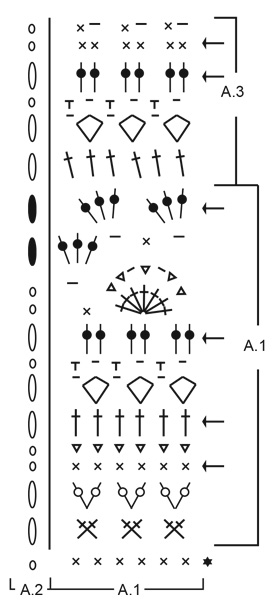
|
|||||||||||||||||||||||||||||||||||||||||||
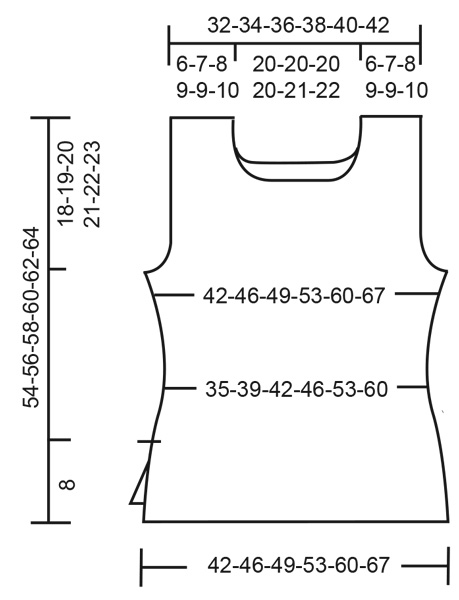
|
|||||||||||||||||||||||||||||||||||||||||||
|
Have you made this or any other of our designs? Tag your pictures in social media with #dropsdesign so we can see them! Do you need help with this pattern?You'll find tutorial videos, a Comments/Questions area and more by visiting the pattern on garnstudio.com. © 1982-2024 DROPS Design A/S. We reserve all rights. This document, including all its sub-sections, has copyrights. Read more about what you can do with our patterns at the bottom of each pattern on our site. |
|||||||||||||||||||||||||||||||||||||||||||







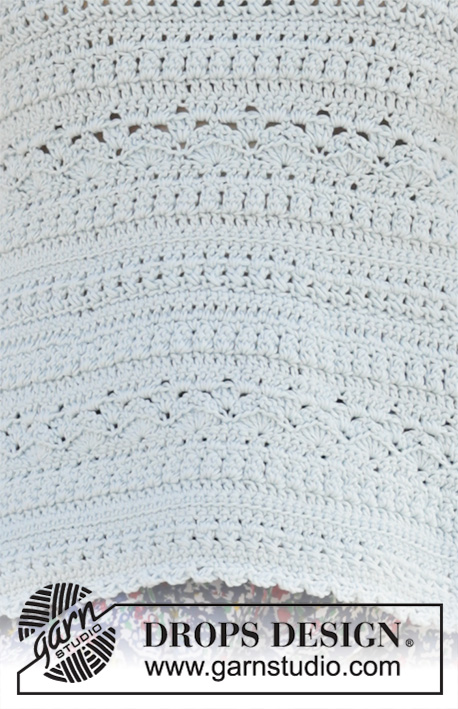





























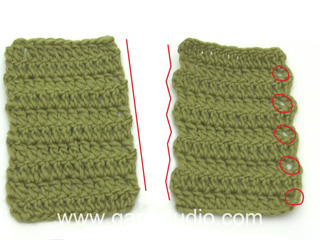






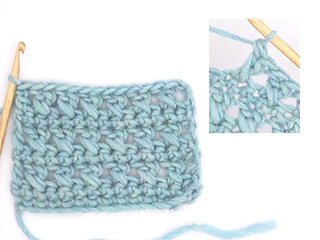
















Comments / Questions (39)
Bonjour, au début du diagramme A1, au 2e rang de mailles serrées, il y a la flèche pour l'augmentation à intervalles réguliers. Mais je n'ai trouvé aucune explication sur les augmentations, uniquement sur les diminutions. Je dois augmenter de combien de mailles?
21.02.2022 - 02:19DROPS Design answered:
Bonjour Diane, les flèches dans les diagrammes s'appliquent uniquement dans la partie TOP après les fentes côtés: quand il est indiqué de diminuer dans un premier temps puis d'augmenter. Tant que vous n'en êtes pas à cette partie-là, crochetez le diagramme sans vous préoccuper des flèches. Bon crochet!
21.02.2022 - 10:18Bonjour, modèle 199 52, après avoir réuni dos et devant par NC j'ai 198 m au lieu des 144 m (taille s) après les fentes côtés, ou est mon erreur ? Merci.
13.09.2020 - 18:59DROPS Design answered:
Bonjour Fabi, vous devez avoir pour le dos et le devant 72 mailles, et donc, quand vous les réunissez vous aurez 72x2= 144 m. N'auriez vous pas oublié de sauter des mailles en l'air à intervalles réguliers au tout premier rang pour crocheter A.1 sur 72 mailles serrées et non sur 83 mailles en l'air? Bon crochet!
14.09.2020 - 09:10Dit patroon 199 52 dat begrijp ik niet je moet het achterpand tot 8 centimeter dan het voor pand haken hoe verder groete dina
28.07.2020 - 22:55DROPS Design answered:
Dag Dina,
Je haakt eerst het achterpand van onder naar boven. De 8 cm is de lente van het split. Daarna leg je het achterpand aan de kant en haak je het voorpand ook tot 8 cm. Daarna haak je het voor- en achterpand samen in de rondte.
02.08.2020 - 19:18Sorry, the chart is very difficult to read. I’m stopping a couple rows after the shells because the next rows do not look right. Makes a nice head wrap though. I believe there are many of us who prefer a written out pattern, perhaps you can have someone do that and add it to your website. Much love, Suzan
25.07.2020 - 23:40DROPS Design answered:
Dear Mrs Franz, you will find more help with diagrams in this lesson where we explain how to read a crochet diagram. Happy crocheting!
29.07.2020 - 12:33Dat is toch het patroon 199. 52 van muscat
20.07.2020 - 20:38DROPS Design answered:
Dag Dina,
Dit patroon wordt inderdaad met muskat gebreid.
23.07.2020 - 11:33Hi I am new to crocheting and have just completed two patterns with no problem at all. But i am having difficulty understanding this pattern ref the Small upside down triangle (row 4 in A1), It states dc in back loop of stitch and in front loop of stitch, So therefore do you end up with 2 dc in the same stitch am i reading this correct please, also the explanations shows triangle upright but diagram shows upside down ? but i presume this is a print error, any help would be good Many Thanks
20.07.2020 - 18:09DROPS Design answered:
Dear Mrs Green, on that row you work only 1double crochet in each stitch, when this row will be worked from RS you will work in the back loop of the stitches and when this row will be worked from WS you will work in the front loop of stitches (= 1 stitch in each stitch all the row). Happy crocheting!
29.07.2020 - 08:19Waarom zijn die patronen moeilijk te begrijpen wat je moet doen
20.07.2020 - 14:34DROPS Design answered:
Dag Dina,
We proberen de patronen zo goed mogelijk voor iedereen te beschrijven. Ook staan bij elk patroon instructievideo's die je kunt bekijken. Daarnaast kun je een lijst met veel gestelde vragen vinden. Als je iets niet begrijpt kun je een vraag posten en aangeven waar je precies tegenaan loopt, zodat we kunnen proberen je te helpen.
23.07.2020 - 11:29Het gaat erom je moet bijde panden haken tot 8 centimeter ik heb de voorpand met drie lossen aanmekaar gehaakt hoe gaat het verder da Dank je
20.07.2020 - 10:14DROPS Design answered:
Dag Dina,
Je kan het voorpand met een halve vaste aan het achterpand vast maken en daarna gewoon verder haken.
23.07.2020 - 10:57Ik begrijp. Het patroon niet van dit topje
19.07.2020 - 13:43DROPS Design answered:
Dag Dina,
Zou je wat specifieker aan kunnen geven waar je tegenaan loopt. Dan kunnen we je wellicht beter helpen? Heb je al een proeflapje gemaakt om te controleren of de stekenverhouding klopt?
20.07.2020 - 08:32Doit on faire A2 lorsqu'on débute l'ouvrage avec A1, ou doit on débuter uniquement avec A1 ?
11.06.2020 - 16:45DROPS Design answered:
Bonjour Fabienne, on ne crochète qu'A.1 au début, mais vous pouvez tout à fait commencer chaque rang par A.2 (sans les mailles coulées bien sûr). Bon crochet!
12.06.2020 - 07:23